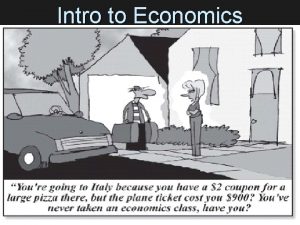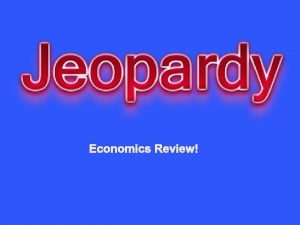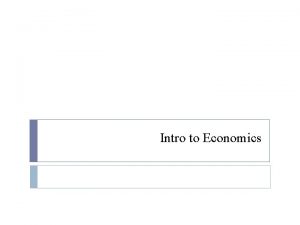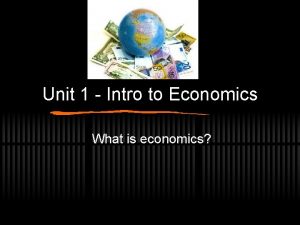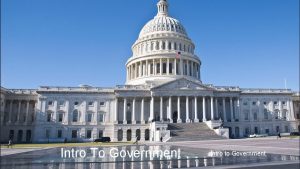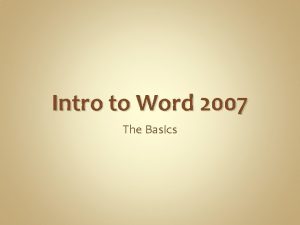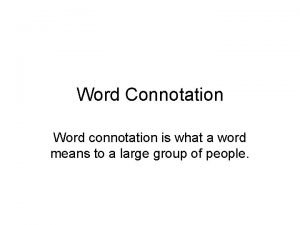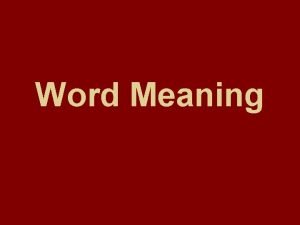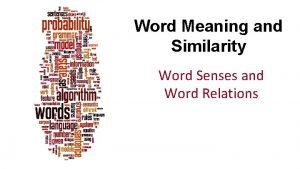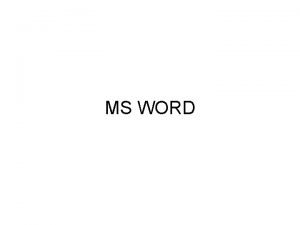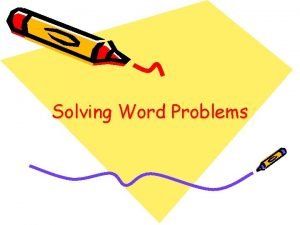Unit 1 Intro to Economics Economics The word



































- Slides: 35

Unit 1: Intro to Economics

Economics • The word economy comes from a Greek word for “one who manages a household. ” • What are we managing? – Our unlimited wants and needs, but how do we know they are unlimited?

BASIC PRINCIPLES OF ECONOMICS Society and Scarce Resources: – We use resources to meet wants and needs. Unfortunately, these resources are (almost always) limited. • Factors Of Production – Land, Labor, Capital, Ideas/Entrepreneurs » Physical Capital VS Human Capital – Scarcity means that society has limited resources and therefore cannot produce all the goods and services people wish to have, so we have to make a choice about how those resources will be distributed. ECONOMICS IS THE STUDY OF SCARCITY

Principle #1: People Face Tradeoffs. “There is no such thing as a free lunch!”

Principle #1: People Face Tradeoffs. Because of scarcity, to get one thing, we usually have to give up another thing. – Guns v. butter – Food v. clothing – Leisure time v. work – Efficiency v. equity Why does picking your college major matter?

Principle #1: People Face Tradeoffs • The Three Economic Questions – What to produce? • Goods VS Services • Capital Goods VS Consumer Goods • Durable Goods VS Non-durable Goods – How to produce? – For whom to produce?

Principle #1: People Face Tradeoffs • • Goals of a society Economic Efficiency – Refers to how well scarce productive resources are allocated to produce the goods and services people want and how well inputs are used in the production process to keep production costs as low as possible. • Allocative VS Productive • Economic Equity • Economic Freedom • Economic Growth • Economic Security – Means what is “fair. ” Economic actions and policies have to be evaluated in terms of what people think is right or wrong. This usually deals with questions of income and wealth. Equal outcomes VS equal opportunities. – Refers to things such as the freedom for consumers to decide how to spend and save their incomes, the freedom of workers to change jobs and join unions, and the freedom of individuals to establish new businesses and close old ones. – Refers to increasing the production of goods and services over time. – Refers to protecting consumers, producers, and resource owners from risks that exist in society. Each society must decide from which uncertainties individuals can and should be protected and whether individuals, employers, or the government should pay for this protection. • Economic Stability – Getting smooth and steady growth over time with low unemployment and inflation.

Principle #2: The Cost of Something Is What You Give Up to Get It. • Decisions require comparing costs and benefits of alternatives. – Whether to go to college or to work? – Whether to study or go out on a date? – Whether to go to class or sleep in? • The opportunity cost is the loss of the next best alternative that is forgone when we make a choice. – Implicit VS Explicit • Economics measures both of these

Principle #2: The Cost of Something Is What You Give Up to Get It. • The production possibilities frontier is a graph that shows the combinations of output that the economy can possibly produce given the available factors of production and the available production technology. – It shows what you can produce given your resources.

The Production Possibilities Frontier Quantity of Computers Produced 3, 000 D C 2, 200 2, 000 A Production possibilities frontier B 1, 000 0 300 600 700 1, 000 Quantity of Cars Produced Copyright© 2003 Southwestern/Thomson Learning

Principle #2: The Cost of Something Is What You Give Up to Get It. • Concave shape of curve illustrates the concept of increasing opportunity costs – Not all resources are easily transferable

Principle #2: The Cost of Something Is What You Give Up to Get It. • Concepts Illustrated by the Production Possibilities Frontier – Efficiency – Scarcity and Tradeoffs – Opportunity Cost – Economic Growth • Increasing standards of living – Caused by… » Resources » Productivity • Technology • Human Capital

A Shift in the Production Possibilities Frontier Quantity of Computers Produced 4, 000 3, 000 2, 100 2, 000 0 E A 700 750 1, 000 Quantity of Cars Produced Copyright © 2004 South-Western

Principle #3: Rational People Think at the Margin. • Marginal = The Extra • Marginal changes are small, incremental adjustments to an existing plan of action. • Marginal Benefit – The extra benefit of one more • Revenue for businesses and utility for individuals – Benefit will correlate with the value that we place on the product • Paradox of Value – The contradiction between the high value nonessentials and low value of essentials – Law of Diminishing Marginal Returns/Utility/Benefit • Shape on a graph?

Principle #3: Rational People Think at the Margin. • Marginal Cost – The extra cost of one more unit – Increasing Marginal Costs • Due to convex PPC • Shape on a graph?

Principle #4: People Respond to Incentives. • Individuals have an INCENTIVE to profit from a transaction. – Hope of reward or fear of punishment that encourages people to behave in a certain way. • Marginal changes in costs or benefits motivate people to respond. • We only choose to do something (make a rational decision) when it maximizes total profit.

Principle #4: People Respond to Incentives. • Utility is want satisfying power • Marginal utility is extra utility gained • Law of diminishing marginal utility is the fact that utility decreases as you get more of a product • Total utility is total satisfaction gained • Goal is to maximize total utility given your budget constraint

Principle #5: Trade Can Make Everyone Better Off. • People gain from their ability to trade with one another. • Competition results in gains from trading. • Trade allows people to specialize in what they do best and creates a division of labor within and between societies.

Interdependence and the Gains from Trade • Why aren’t your parents farmers? • How do we satisfy our wants and needs in a global economy? – We can be economically self-sufficient. – We can specialize and trade with others, leading to economic interdependence. • Leads to increases in allocative and productive efficiency

Interdependence and the Gains from Trade • Individuals and nations rely on specialization and trade to satisfy wants and needs, but this gives rise to two questions: – Why is interdependence the norm? • We are better off because of it. – What determines production and trade? • Differences in opportunity costs

A PARABLE FOR THE MODERN ECONOMY • Imagine. . . – only two goods: potatoes and meat • only two people: a potato farmer and a cattle rancher • What should each produce? • Why should they trade?

The Production Opportunities of the Farmer and Rancher Copyright © 2004 South-Western

Absolute VS Comparative Advantage • Absolute – Can produce more. – Require smaller quantity of inputs – In other words…you’re better at it • Comparative – Can produce at a lower opportunity cost. – In other words…it costs you less – Whenever potential trading parties have differences in opportunity costs, they can each benefit from trade.

The Production Opportunities of the Farmer and Rancher Copyright © 2004 South-Western

Principle #6: Markets Are Usually a Good Way to Organize Economic Activity. • A market economy is an economy that allocates resources through the decentralized decisions of many firms and households as they interact in markets for goods and services. – Households decide what to buy and who to work for. – Firms decide who to hire and what to produce.

Principle #6: Markets Are Usually a Good Way to Organize Economic Activity. • Adam Smith made the observation that households and firms interacting in markets act as if guided by an “invisible hand. ” – Because households and firms look at prices when deciding what to buy and sell, they unknowingly take into account the social costs of their actions. – As a result, prices guide decision makers to reach outcomes that tend to maximize the welfare of society as a whole. – “Laissez Faire”

Principle #6: Markets Are Usually a Good Way to Organize Economic Activity. • Characteristics of Market Economies – Economic Freedom – Voluntary Exchange – Private Property • Forces individuals to care for and preserve property in order to make a profit. Helps us avoid the Tragedy of the Commons. – Profit Motive – Capitalism – Competition

Principle #6: Markets Are Usually a Good Way to Organize Economic Activity. • Roles in the system – Consumer • Consumer sovereignty – Entrepreneur – Government • Ways to organize an economy – Traditional – Command – Market – Mixed

Principle #7: Governments Can Sometimes Improve Market Outcomes. • Market failure occurs when the market fails to allocate resources efficiently. • When the market fails (breaks down) government can intervene to promote efficiency and equity.

Principle #8: The Standard of Living Depends on a Country’s Production. • Almost all variations in living standards are explained by differences in countries’ productivities. • Productivity is the amount of goods and services produced from each hour of a worker’s time. • Increases in productivity lead to economic growth.

The Role of Assumptions and Models • Economists make assumptions in order to make the world easier to understand. – Ceteris Paribus • The art in scientific thinking is deciding which assumptions to make. • Economists use different assumptions to answer different questions.

Economic Models • Economists use models to simplify reality in order to improve our understanding of the world • A model is not the real world!!! It just helps us understand the real world better.

Our Second Model: The Circular-Flow Diagram • The circular-flow diagram is a visual model of the economy that shows how dollars flow through markets among households and firms.

The Circular Flow Revenue Goods and services sold MARKETS FOR GOODS AND SERVICES • Firms sell • Households buy Wages, rent, and profit Goods and services bought HOUSEHOLDS • Buy and consume goods and services • Own and sell factors of production FIRMS • Produce and sell goods and services • Hire and use factors of production Factors of production Spending MARKETS FOR FACTORS OF PRODUCTION • Households sell • Firms buy Labor, land, and capital Income = Flow of inputs and outputs = Flow of dollars Copyright © 2004 South-Western

Microeconomics and Macroeconomics • Microeconomics focuses on the individual parts of the economy. – How households and firms make decisions and how they interact in specific markets • Macroeconomics looks at the economy as a whole. – Economy-wide phenomena, including inflation, unemployment, and economic growth
 Bivariate data examples
Bivariate data examples Unit 1 intro to government review guide
Unit 1 intro to government review guide Unit 6 review questions
Unit 6 review questions Hát kết hợp bộ gõ cơ thể
Hát kết hợp bộ gõ cơ thể Slidetodoc
Slidetodoc Bổ thể
Bổ thể Tỉ lệ cơ thể trẻ em
Tỉ lệ cơ thể trẻ em Voi kéo gỗ như thế nào
Voi kéo gỗ như thế nào Tư thế worm breton
Tư thế worm breton Hát lên người ơi
Hát lên người ơi Các môn thể thao bắt đầu bằng tiếng nhảy
Các môn thể thao bắt đầu bằng tiếng nhảy Thế nào là hệ số cao nhất
Thế nào là hệ số cao nhất Các châu lục và đại dương trên thế giới
Các châu lục và đại dương trên thế giới Công của trọng lực
Công của trọng lực Trời xanh đây là của chúng ta thể thơ
Trời xanh đây là của chúng ta thể thơ Mật thư tọa độ 5x5
Mật thư tọa độ 5x5 Phép trừ bù
Phép trừ bù độ dài liên kết
độ dài liên kết Các châu lục và đại dương trên thế giới
Các châu lục và đại dương trên thế giới Thể thơ truyền thống
Thể thơ truyền thống Quá trình desamine hóa có thể tạo ra
Quá trình desamine hóa có thể tạo ra Một số thể thơ truyền thống
Một số thể thơ truyền thống Cái miệng bé xinh thế chỉ nói điều hay thôi
Cái miệng bé xinh thế chỉ nói điều hay thôi Vẽ hình chiếu vuông góc của vật thể sau
Vẽ hình chiếu vuông góc của vật thể sau Nguyên nhân của sự mỏi cơ sinh 8
Nguyên nhân của sự mỏi cơ sinh 8 đặc điểm cơ thể của người tối cổ
đặc điểm cơ thể của người tối cổ V. c c
V. c c Vẽ hình chiếu đứng bằng cạnh của vật thể
Vẽ hình chiếu đứng bằng cạnh của vật thể Tia chieu sa te
Tia chieu sa te Thẻ vin
Thẻ vin đại từ thay thế
đại từ thay thế điện thế nghỉ
điện thế nghỉ Tư thế ngồi viết
Tư thế ngồi viết Diễn thế sinh thái là
Diễn thế sinh thái là Các loại đột biến cấu trúc nhiễm sắc thể
Các loại đột biến cấu trúc nhiễm sắc thể Các số nguyên tố là gì
Các số nguyên tố là gì





































